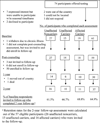Melanoma genetic counseling and test reporting improve screening adherence among unaffected carriers 2 years later
- PMID: 23950214
- PMCID: PMC3837428
- DOI: 10.1158/1055-9965.EPI-13-0422
Melanoma genetic counseling and test reporting improve screening adherence among unaffected carriers 2 years later
Abstract
Background: A major goal of predictive genetic testing for melanoma is to promote early detection to reduce mortality. This study evaluated the long-term impact of melanoma genetic test reporting and counseling on screening adherence.
Methods: This study assessed adherence to recommendations for annual total body skin examinations (TBSE) and monthly skin self-examinations (SSE) among 37 members of Utah CDKN2A/p16 kindreds (10 unaffected carriers, 11 affected carriers, and 16 unaffected noncarriers; response rate = 64.9% of eligible participants).
Results: Two years following test reporting, adherence to annual TBSE among unaffected carriers increased from 40% to 70%. However, unaffected noncarriers' adherence decreased from 56% to 13%. Affected carriers reported TBSEs at both assessments (91% and 82%, respectively). Monthly SSE frequency remained highly variable in all patient groups: at 2 years, 29.7% reported monthly SSEs, 27.0% reported more frequent self-examinations, and 43.2% reported underscreening. However, SSE quality improved significantly: participants checked more body sites at 2 years than at baseline, especially feet, shoulders, legs, and genitals. Perceived logistic barriers to TBSEs (e.g., expensive, inconvenient) and SSEs (hard to remember, time-consuming) predicted lower adherence.
Conclusions: Unaffected carriers reported increased TBSE adherence and thoroughness of SSEs 2 years following melanoma genetic test reporting, suggesting clinical benefit in this modest sample. Unaffected noncarriers reported comparable gains in SSE thoroughness, but decreased TBSEs.
Impact: Melanoma genetic counseling and test reporting may improve adherence among unaffected carrier members of p16 families. Further interventions to reduce logistic barriers and to promote continued screening adherence among unaffected noncarrier family members may be needed.
Conflict of interest statement
There are no conflicts of interest
Figures





References
-
- Khoury MH, Gwinn M, Yoon PW, Dowling N, Moore CA, Bradley L. The continuum of translation research in genomic medicine: how can we accelerate the appropriate integration of human genome discoveries into health care and disease prevention? Genet Med. 2007;9(10):665–674. - PubMed
-
- Collins FS, Green ED, Guttmacher AE, Guyer MS. A vision for the future of genomics research. Nature. 2003;422(6934):835–847. - PubMed
-
- Bishop DT, Demenais F, Goldstein AM, Bergman W, Bishop JN, Bressac-de Paillerets B, et al. Geographical variation in the penetrance of CDKN2A mutations for melanoma. J Natl Cancer Inst. 2002;94:894–903. - PubMed
-
- Balch CM, Buzaid AC, Soong SJ, Atkins MB, Cascinelli N, Coit DG, et al. Final version of the American Joint Committee on Cancer staging system for cutaneous melanoma. J Clin Oncol. 2001;19:3635–3648. - PubMed
-
- Howlader N, Noone AM, Krapcho M, Neyman N, Aminou R, Altekruse SF, et al., editors. Bethesda, MD: National Cancer Institute; 2012. Apr, SEER Cancer Statistics Review, 1975–2009. http://seer.cancer.gov/csr/1975_2009_pops09/, based on November 2011 SEER data submission, posted to the SEER web site.
Publication types
MeSH terms
Grants and funding
LinkOut - more resources
Full Text Sources
Other Literature Sources
Medical
Miscellaneous

